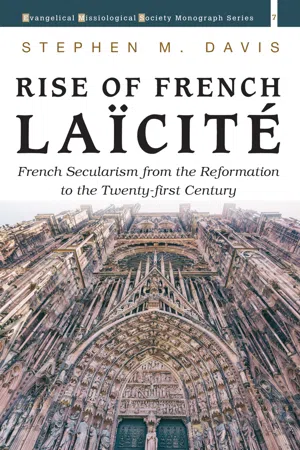![]()
6
Twenty-First-Century Challenges to Laïcité
French society accommodated itself to religious changes in the twentieth century following the disestablishment of concordataire state churches. The arrival of the law of 1905 ended decades of harsh combats between political and laïque powers. The law was both a law of rupture and a law of conciliation. The rupture was considered justified by many since the Church was a threat to the Republic. The conciliation was a guarantee of the free exercise of religion and the liberty of conscience. Jean-Michel Bélorgey describes French laïcité as a response to confrontations between the Catholic Church and political powers and to several centuries of religious quarrels which profoundly marked and bloodied French society, and as an attempt to battle the imperialism of the Catholic Church of France, the eldest daughter of the Church.
We saw previously that by 1924, the Catholic Church accepted its new status and adapted accordingly to its diminished prestige, influence, and numbers. The Catholic Church waited until the twentieth century to recognize the freedom of conscience, the autonomy of scientific inquiry, and the equality of all people, believers or not—all the things that Pope Pius IX still anathematized in his 1864 Syllabus. The Church continued to believe that the Law of Separation was contrary to the order willed by God, but could be accommodated from the moment the State respected the rights and the liberties of the Church. Radical transformation in the Catholic Church in France followed in the fifty years after Vatican II. Both the Catholic Church and its adversaries came to accept the idea of a State serving all citizens and no longer subject to religious belief. There was optimism that the Church had in itself the spiritual resiliency to remove itself from the nostalgia of an idealized past in order to put itself without reserve at the service of a laïque society, to contribute along with all others, to invent a better humanity in the present civilization.
The law of 1905 evolved in the twentieth century, particularly between World War I and World War II, and mostly in relation to questions of education. It was understood that the public school was both the realization of a particular political organization and of specific religious and moral options. The public school’s primary purpose remained the formation of young citizens according to republican values. Soppelsa argues that the evolution of the concept of laïcité was modest for most of the twentieth century and that its structure, its coherence and its objectives were not fundamentally questioned. Matthew Kaemingk maintains that “the utter dominance of secular liberalism in Europe during the twentieth century created the impression that the question of faith and public life had all been laid to rest and that the problem of public religion had been solved.”
Toward the end of the twentieth century, the concept of laïcité began to develop beyond its traditional sense of separation of Church and State and the concept of State neutrality. Laïcité was conceived in a new manner and generally in terms of freedom. Traditional laïcité appeared outdated and inadequate. The opening years of the twenty-first century in France presented contemporary challenges for laïcité and applications of the law of 1905. For that reason, in 2006 laïcité could be described as a modern idea requiring systematic promotion because it remained more than ever the prerequisite for economic, social, and political progress at the beginning of a new millennium. Indeed, in the last few decades the subject of laïcité returned to prominence in French society. What began as a trickle of books on laïcité in the late 1900s became a torrent in the early twenty-first century. The multitude of studies which have been consecrated to laïcité led to blurring the notion rather than clarifying it.
Many of the concerns and questions raised in the twenty-first century are far removed from issues debated and resolved at the time of the law of 1905. It has been noted that within a year or two of the centennial of the law of 1905 there was an extraordinary upsurge in laïque debate in France concerning a question—the wearing of symbols or clothing by which students ostensibly manifested a religious commitment—which certainly was nothing new but which was hardly an issue in the debates of 1905. Islam presented the problem of laïcité in a different manner to French and European society. The problem was not the long presence of Muslims in France, but the radicalization of Islam in the 1990s. The issues now incl...
